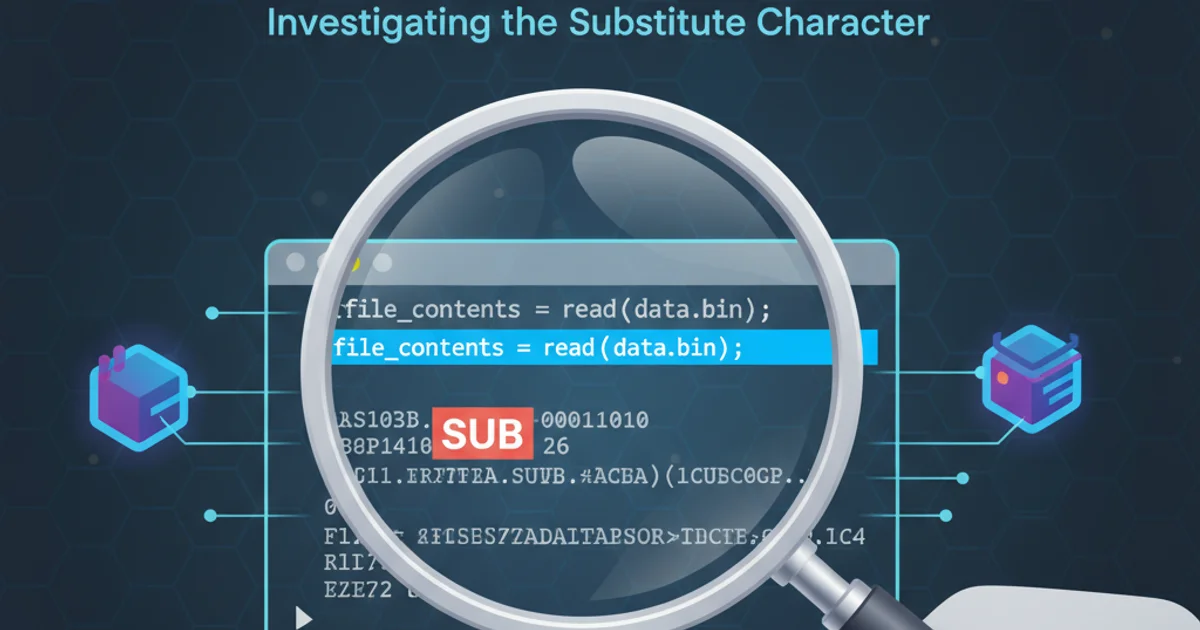cannot read ascii character 26?
Categories:
Decoding the Enigma: Handling ASCII Character 26 (SUB) in Python

Explore the challenges of reading files containing ASCII character 26 (SUB) in Python, particularly on Windows, and learn effective strategies for robust file processing.
When working with files, especially those originating from older systems or specific applications, you might encounter unexpected characters that disrupt your Python scripts. One such character is ASCII 26, also known as the Substitute (SUB) character. This character, often represented as \x1a or ^Z, historically marked the end of a file in some operating systems, particularly MS-DOS and early Windows versions. When Python encounters this character, it can lead to premature file termination or decoding errors, making it crucial to understand how to handle it effectively.
The Nature of ASCII 26 (SUB) and its Impact
ASCII character 26 (SUB) is a control character. In the context of file systems, its primary historical role was to signal the End-Of-File (EOF) marker for text files. While modern operating systems and file formats typically use explicit file size information to determine EOF, the legacy of ^Z persists. When Python opens a file in text mode on Windows, the C runtime library (which Python uses for file I/O) might interpret \x1a as an EOF marker, causing the file reading operation to stop prematurely, even if more data follows. On Unix-like systems, this behavior is generally not observed, as \x1a is treated as any other character.
flowchart TD
A[Start File Read] --> B{Operating System?}
B -->|Windows| C{Text Mode?}
C -->|Yes| D[C Runtime Interprets \"\x1a\" as EOF]
D --> E[File Read Terminates Prematurely]
C -->|No (Binary Mode)| F[Reads \"\x1a\" as Regular Byte]
F --> G[Continue Reading]
B -->|Unix/Linux| H[Treats \"\x1a\" as Regular Character]
H --> G
G --> I[End File Read]Impact of ASCII 26 on File Reading Across Operating Systems
Strategies for Handling ASCII 26
There are several robust strategies to deal with ASCII 26, depending on whether you need to preserve it, remove it, or simply ensure it doesn't prematurely terminate your file reading. The most common and effective approach is to open the file in binary mode, which bypasses the text-mode-specific EOF interpretation.
\x1a is more likely.# Strategy 1: Open in binary mode ('rb') and decode
with open('your_file.txt', 'rb') as f:
binary_content = f.read()
# Decode the binary content, handling potential errors
# 'latin-1' is often a safe choice for arbitrary bytes
# 'utf-8' might fail if the file isn't valid UTF-8
try:
decoded_content = binary_content.decode('utf-8')
except UnicodeDecodeError:
decoded_content = binary_content.decode('latin-1')
# Now you can process decoded_content, which includes \x1a if present
print(f"Content (binary mode): {repr(decoded_content)}")
# Strategy 2: Remove \x1a after reading (in binary mode)
cleaned_content = decoded_content.replace('\x1a', '')
print(f"Content (cleaned): {repr(cleaned_content)}")
# Strategy 3: Open in text mode with explicit encoding and error handling
# This might still stop at \x1a on Windows if not handled carefully
# The 'errors' parameter helps with other decoding issues, but not EOF for \x1a
with open('your_file.txt', 'r', encoding='latin-1', errors='ignore') as f:
text_content = f.read()
print(f"Content (text mode, latin-1): {repr(text_content)}")
Python code demonstrating different strategies for handling ASCII 26.
Best Practices and Considerations
When dealing with files that might contain problematic characters like ASCII 26, adopting a defensive programming approach is key. Always be explicit about encoding, especially when dealing with files from diverse sources. Binary mode ('rb') offers the most control, as it reads the file byte-for-byte without any special interpretation of control characters by the C runtime. After reading in binary mode, you can then decode the bytes to a string using an appropriate encoding, and then perform any necessary cleaning (e.g., removing \x1a).
encoding='utf-8' directly in text mode ('r') might not prevent premature termination on Windows if \x1a is encountered, as the underlying C runtime's EOF interpretation takes precedence. Binary mode is generally safer for this specific issue.1. Identify Potential Problem Files
If you suspect a file might contain ASCII 26 or other non-standard characters, especially if it's from an older system or a non-UTF-8 source, prepare to handle it defensively.
2. Open File in Binary Mode
Use open('filename', 'rb') to read the file as a sequence of bytes. This bypasses any special interpretation of control characters by the operating system's C runtime.
3. Decode Bytes to String
After reading the binary content, decode it to a string using a suitable encoding. latin-1 (ISO-8859-1) is often a good fallback for arbitrary bytes as it maps every byte value to a unique character. If you expect a specific encoding, use that, but be prepared for UnicodeDecodeError.
4. Clean or Process the Content
Once decoded, you can use string methods like .replace('\x1a', '') to remove the substitute character if it's not needed, or process the content as is if \x1a has semantic meaning in your context.